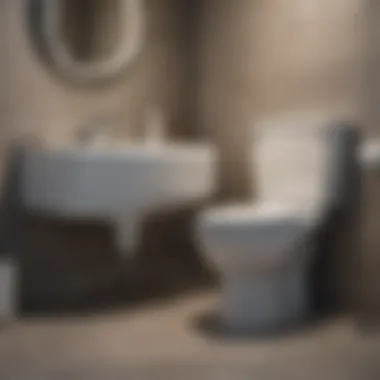Effective Strategies for Clogged Toilet Troubles


Intro
A clogged toilet is more than an inconvenience; it presents a disruption that impacts daily routines. This guide provides a thorough exploration of the underlying causes, practical solutions, and effective prevention strategies against clogs.
Understanding how toilets function enhances our ability to manage plumbing issues. From the simple mechanisms within the toilet to the complex interactions with the sewer system, knowledge empowers homeowners and renters alike. This knowledge is crucial when facing a potential plumbing disaster.
It is vital to recognize common causes that lead to clogs. Items like excessive toilet paper, foreign objects, and plumbing issues can obstruct flow and cause stress. Moreover, being aware of the proper maintenance steps ensures that one can handle minor issues before they escalate.
"Prevention is easier than dealing with the aftermath of a clog."
Arming oneself with effective tools and techniques for resolving these issues can save time and money. This article serves as a guide to navigate the common pitfalls associated with toilet maintenance and operation, as well as presenting strategies to maintain the plumbing system in peak condition.
Understanding the Clogged Toilet
A clogged toilet represents more than just an inconvenience; it can reflect underlying plumbing problems and impact daily life. Understanding the intricacies of toilet clogs allows homeowners to respond effectively, reducing stress and potential damage. Many homeowners neglect the toilet's functionality until a problem arises. Knowing how a toilet works, its components, and the common causes of clogs is essential in managing plumbing. This section allows readers to appreciate the importance of proper toilet usage and maintenance.
Definition and Impact
A clogged toilet occurs when water cannot flow through the bowl and drainage system as intended. This blockage can arise from various sources such as excessive waste, foreign objects, or mineral build-up. The impact of a clog goes beyond immediate inconvenience; it can lead to overflows, unpleasant odors, and even damage to bathroom fixtures. Moreover, a frequent issue may indicate a larger plumbing problem that could escalate, leading to costly repairs.
Understanding the definition helps clarify the operational efficiency of a toilet. This knowledge can guide users in recognizing signs of a problem before it worsens, saving both time and money in the long run.
Frequency and Common Occurrences
Toilet clogs are among the most common plumbing issues in households. Statistics suggest that about 15% of all households experience clogs at least once a year. While many clogs may seem trivial, they often arise in specific situations:
- Overloading the toilet with waste or toilet paper
- Inadvertently flushing items such as disposable wipes or hygiene products
- Older plumbing systems prone to mineral build-up
The frequency with which these issues occur points to the necessity of preventive measures. Many homeowners encounter clogs during a high usage period, like family gatherings or after-childbirth situations, when usage tends to increase significantly. Consequently, a clear understanding of these scenarios can better prepare households to mitigate clogs effectively.
Basic Anatomy of a Toilet
Understanding the basic anatomy of a toilet is crucial for addressing clogs effectively. Grasping how each component works helps in diagnosing issues and finding solutions. It allows homeowners to act quickly and correctly, limiting damage and inconvenience. Knowing the basic mechanics supports better maintenance practices, ensuring toilets function optimally over time.
Components and Mechanics
A standard toilet consists of several key components, with each part having its own role. The main parts include the tank, bowl, flapper, fill valve, flush valve, and trapway. The tank stores water, while the bowl holds waste. The flapper is a rubber seal that controls water flow from the tank to the bowl during a flush.
- Tank: Contains water up to a determined level, ready for flushing.
- Bowl: Designed to manage waste with a curvature that aids in the cleansing process.
- Flapper: Opens to allow water to flow and closes to seal when flushing is done.
- Fill Valve: Regulates the filling cycle after a flush, ensuring the tank replenishes appropriately.
- Flush Valve: Connects the tank and bowl, allowing water to flush waste.
- Trapway: A pathway that moves waste from the bowl into the sewer line, shaped to prevent odors from escaping back into the home.
Understanding these components helps in diagnosing problems, such as a non-flushing toilet or slow fill issues.
Water Flow Dynamics
Water flow dynamics in a toilet are essential for proper function. During a flush, water from the tank rushes into the bowl, creating a siphoning effect that draws waste out of the trapway. The sudden influx of water must be strong enough to carry waste but balanced to minimize splashing.
It's important to note:
- Pressure: Adequate water pressure is vital. Low pressure can lead to incomplete flushing and eventual clogs.
- Velocity: The speed at which water enters the bowl affects how efficiently waste is removed.
- Gravity: Gravity aids in moving the waste through the trapway, making the design critical to effective function.
The interaction between these factors defines the efficiency of toilet operation. Poor dynamics may lead to frequent clogs and ineffective waste removal.
Understanding the fundamental workings of a toilet empowers homeowners to tackle clogs proactively and maintain effective plumbing, reducing frustrations.
Common Causes of Toilet Clogs
Understanding the common causes of toilet clogs is essential in addressing this prevalent household issue. Recognizing these causes not only helps homeowners manage their toilets more effectively, but it can also prevent potential complications down the line. Engaging with this topic equips readers with the necessary tools to maintain their plumbing systems, ultimately saving time, money, and stress. Here, we explore three major contributors to toilet clogs.
Excessive Toilet Paper Usage


Toilet paper is designed to disintegrate in water, yet excessive usage can lead to significant blockages. When too much paper is flushed at once, it can create a mass that does not break down sufficiently. This mass can become lodged in the toilet trap, restricting the flow of water and leading to a complete blockage. Many people underestimate how much toilet paper they really need. Helpful practices include using smaller amounts per flush and ensuring any necessary disposal of paper is done gradually.
"Using just the right amount of toilet paper can drastically reduce the likelihood of clogs."
Foreign Objects
Foreign objects represent another frequent cause of toilet clogs. Items like sanitary products, wipes, toys, or cotton balls are often disposed of improperly and can easily become trapped in the plumbing. Importantly, some of these objects do not break down in water as intended. Encouraging proper disposal habits is vital. Households should implement clear guidelines about what can and cannot be flushed. Investing in sturdy waste baskets near toilets can also mitigate this issue, redirecting items that should not be flushed into appropriate bins.
Mineral Build-up
Over time, mineral build-up can contribute to toilet clogging. Minerals from hard water, such as calcium and magnesium, accumulate in the pipes and toilet components. This build-up restricts water flow and increases the chances of a clog. Regular maintenance becomes crucial in this case. Homeowners can consider using products designed to repel mineral accumulation. Additionally, periodic cleaning of the toilet and plumbing system can help maintain optimal function.
Diagnostic Steps for Homeowners
Understanding how to diagnose a clogged toilet is crucial for homeowners. Accurate diagnostics can save time, money, and unnecessary frustration. By methodically examining the situation, one can identify the source of the problem and determine the most suitable course of action. This process not only aids in resolving the immediate issue but also enhances overall plumbing awareness, which can prevent future complications.
Initial Observations
Upon noticing a clogged toilet, the first step is to assess the situation. This includes watching how the toilet behaves when flushed. Is there a complete blockage, or does the toilet slowly drain? Observe any unusual noises, such as gurgling sounds or water rising in the bowl.
Look for any visible signs of trouble. Is there water accumulating on the floor or around the base? This can indicate leaks or faults in the plumbing. Taking these initial observations seriously can provide essential clues to the underlying issue.
Testing the Flush Mechanism
Testing the flush mechanism can help identify if the problem lies within the toilet itself. Lift the tank lid and inspect the components such as the flapper, fill valve, and float. If the flapper does not seal properly, it can lead to inadequate flushing. Check if the fill valve is functioning as intended. A toilet that does not refill may cause repeated clogs. Conduct a test flush and observe if the water level drops appropriately. This evaluation is instrumental in understanding whether the clog is due to mechanical failure or an actual blockage in the plumbing.
Inspecting the Toilet Trap
The toilet trap is a hidden yet critical component that can cause serious clogs. To inspect it, you might need to remove the toilet from the floor, which is not a simple task but may be necessary in some cases. Look for visible buildups of debris or accumulated waste. If undetected clogs exist in this area, they can lead to recurrent disturbances. Always ensure you turn off the water supply before attempting any inspections. Remember, handling plumbing can be tricky, and knowing what to look for makes a significant difference in effective troubleshooting.
Diagnosing plumbing issues accurately can prevent further damage and costly repairs in the future.
Effective Methods for Unclogging
Toilet clogs can disrupt daily routines, often at the least convenient times. Understanding effective methods for unclogging a toilet ensures homeowners respond swiftly and efficiently. This section delves into various techniques that can restore function to a clogged toilet.
Using a Plunger
One of the most essential tools for unclogging a toilet is the plunger. It operates by creating pressure that dislodges blockages. A flange plunger is particularly useful for toilets due to its shape. By placing the plunger over the drain hole and creating a strong downward force, air is pushed into the trap, clearing the obstruction. Ensure a tight seal and use a vigorous up and down motion, which maximizes pressure. After several attempts, flushing the toilet will determine if the blockage has been cleared.
Block quote: "Using a plunger effectively can save time and prevent further plumbing issues."
Snakes and Augers
For more stubborn clogs, a toilet auger might be necessary. This device, often called a plumbing snake, consists of a long, flexible cable that can reach deeper into the toilet trap. Insert the auger into the toilet bowl and gently rotate the handle to navigate through the obstruction. This method avoids the risk of damaging the toilet thanks to the auger's design. After penetrating the clog, it can often be pulled back out, providing a mechanical solution to a persistent blockage. Utilizing a snake can be a more durable approach than plunging, particularly in cases of serious clogs.
Chemical Cleaners
While chemical cleaners provide a quick solution, they should be approached with caution. Products like Drano or Liquid Plumber can effectively dissolve certain types of obstructions, particularly those caused by organic matter. However, they can also be harmful to plumbing systems, especially older pipes. When using these products, follow the instructions carefully, ensuring proper ventilation in the area. It is often wise to use this method as a last resort after trying mechanical solutions. Always consider the environmental impact of chemical cleaners and seek safer alternatives when feasible.
When to Seek Professional Help
Addressing a clogged toilet may seem straightforward, yet there are scenarios where tackling the issue independently may lead to further complications. Recognizing when it is appropriate to consult a plumber is essential for preserving the integrity of your plumbing system and ensuring efficient operations in your home.
Signs of Major Plumbing Issues
Not all toilet clogs stem from simple problems. There are certain indications that suggest a more significant plumbing issue at play. If you notice the following signs, it may be time to call in a professional:
- Multiple Fixtures Clogged: If the toilet, sink, and shower are all backing up, it might indicate a blockage in the main sewer line.
- Gurgling Sounds: Unusual noises from your toilet or other fixtures can signal trapped air in the plumbing system, often due to a serious blockage.
- Foul Odors: Persistent unpleasant smells may suggest waste buildup in the pipes, which could require professional investigation and cleaning.
- Slow Draining: If your toilet drains slowly or backs up consistently, this could point to deeper issues needing serious attention.


These symptoms may seem minor but ignoring them can lead to extensive damage and costly repairs.
Cost Considerations
Understanding the financial implications of professional plumbing services can prepare you for potential costs. The expenses associated with plumbing problems vary based on several factors:
- Type of Issue: Simple clogs may only require basic service fees, while complex problems can escalate costs significantly.
- Location: Urban areas may have different rates compared to rural regions. Proximity to the service provider often affects travel fees as well.
- Emergency Services: If you require immediate assistance, expect to pay a premium for emergency calls, especially during late hours or weekends.
- Extent of Damage: If the clog has led to additional plumbing issues or infrastructure damage, repair costs will increase accordingly.
While the expense may seem daunting, addressing plumbing issues promptly can often save money in the long run by preventing more severe complications. Not every homeowner possesses the expertise required for complex plumbing problems, so consider professional help when in doubt.
"The costs incurred today could be far less than the expenses incurred later if the problem escalates."
Preventive Measures for Clogs
Addressing a clogged toilet effectively requires a proactive approach. Understanding preventive measures is essential in maintaining plumbing systems and avoiding inconvenient breakdowns. Preventing clogs not only saves time and potential damage but also contributes to the overall lifespan of your toilet and plumbing infrastructure. Here are some fundamental aspects to consider:
Proper Disposal Practices
One of the primary causes of toilet clogs is improper disposal of waste. Toilets are not designed to handle materials that do not dissolve or break down easily. Here are some important disposal practices:
- Toilet Paper Only: Use toilet paper sparingly. Less is often more when it comes to preventing clogs.
- No Foreign Objects: Avoid flushing items such as feminine products, wipes, cotton balls, or any other non-biodegradable items. Disposing of these correctly can prevent significant blockages.
- Food waste: If applicable, discourage flushing any food scraps or leftovers down the toilet. This can lead to undesirable buildups within the plumbing.
Implementing proper disposal habits is one of the easiest and most effective measures to minimize clogs.
Regular Maintenance Tips
Routine maintenance plays a crucial role in avoiding plumbing problems. Keeping an eye on your toilet’s performance can identify issues before they escalate. Here are some practices to adopt:
- Visual Inspections: Regular checks to observe for leaks or cracks in the toilet and around the base can help identify issues early.
- Clean Regularly: Use a non-abrasive cleaner designed for toilets. Cleaning helps prevent mineral deposits that can lead to clogging or reduced flow.
- Flushing with Purpose: Make sure to flush regularly and thoroughly to avoid stagnant water, which can accumulate debris.
By adopting a few maintenance routines, the chances of facing an unexpected clog are significantly reduced.
Using Toilet-Friendly Products
Choosing appropriate products for toilet care is essential in preventing clogs. Some cleaning agents can be too harsh or can react negatively with plumbing materials. Consider the following:
- Biodegradable Cleaners: Opt for eco-friendly options that break down organically, reducing the potential for buildup within your plumbing.
- Natural Solutions: Utilizing vinegar or baking soda can effectively minimize blockages without harming pipes.
- Avoid Heavy Chemicals: Stay clear of chemical cleaners that can corrode pipes and cause further issues in the long run.
Selecting suitable products is an integral measure in maintaining toilet health and supporting an efficient plumbing system.
"Prevention is always better than cure. Invest time in preventive measures to keep your plumbing system running smoothly."
Understanding Plumbing Infrastructure
Understanding the plumbing infrastructure is essential when dealing with toilet clogs. The plumbing system in a home is intricate and can affect the overall performance of toilets and other fixtures. By grasping how plumbing works, homeowners can more effectively manage clogs and prevent future issues.
The home plumbing system consists of pipes, valves, fixtures, and fittings that work together to transport water and waste. When a toilet clogs, it's often a reflection of larger issues within this system. Understanding the layout, types of pipes, and how waste flows can simplify diagnostics and repairs.
Home Plumbing Basics
Home plumbing begins with the incoming water supply, which is typically provided by municipal water systems. This water travels through pipes into various areas of the house, including kitchen sinks, bathtubs, and toilets. The plumbing also includes drain-waste-vent systems that remove wastewater from the house.
Key components of home plumbing include:
- Supply Lines: These bring fresh water to fixtures.
- Drain Pipes: These carry waste away.
- Vent Pipes: These ensure that the drainage system operates correctly by allowing air to enter, preventing vacuum lock.
Regular maintenance of these components is vital. Issues like leaks or blockages in the pipes can lead to clogs or water damage. Homeowners should be diligent in recognizing signs of trouble, such as slow drainage or odd noises, which may indicate underlying plumbing issues that could affect the toilet's function.
Community Sewer Systems


The community sewer system connects homes to a larger municipal network. This system is designed to manage the waste from many houses, directing it to treatment facilities. Understanding this infrastructure is critical to grasping how clogs can occur.
Factors affecting community sewer systems include:
- Capacity: If the system is overburdened, it may lead to backups.
- Composition of Waste: Non-biodegradable materials can cause significant issues along the pipeline, impacting multiple homes.
- Environmental Regulations: Municipalities may have regulations restricting the disposal of certain materials into toilets, which can help mitigate clogging problems.
When there's a problem with the community sewer, such as blockages, this can reflect back into individual homes, complicating the plumbing picture.
"Understanding both home plumbing and community sewer systems is essential in effectively addressing toilet clogs."
A thorough comprehension of these elements can empower homeowners. It can prevent unnecessary expense and stress while enhancing the efficiency of plumbing systems.
Environmental Considerations
Understanding the environmental implications of plumbing solutions is crucial in addressing clogged toilets. The choices made in unclogging methods can significantly impact not only the effectiveness of the solutions but also the surrounding ecosystem. Considerations about chemical usage, wastewater treatment, and the longevity of plumbing systems fall under this umbrella.
Impact of Chemical Cleaners
Chemical cleaners, while often marketed as quick fixes for blockages, pose various risks to the environment. Many of these products contain harsh chemicals that can harm aquatic life when they enter the water system. These substances can disrupt the natural balance, leading to detrimental effects on ecosystems. Furthermore, when these chemicals accumulate in pipes, they can corrode plumbing materials, leading to leaks and long-term damage. Thus,
- Environmental Hazard: Chemical cleaners can be harmful if they reach water bodies, impacting fish and plants.
- Plumbing Integrity: The continual use of corrosive products may ultimately necessitate more frequent pipe replacements.
- Wastewater Treatment: Many treatment facilities are not equipped to filter out all harmful chemicals, leading to potential contamination of treated water.
Given these factors, it is essential to think critically about the products chosen for plumbing issues.
"The best way to prevent environmental damage is by opting for solutions that are not just effective but are also gentle on the ecosystem."
Eco-friendly Alternatives
Fortunately, there are several eco-friendly alternatives to harsh chemical cleaners. Natural ingredients can often provide effective unclogging solutions without the negative consequences associated with chemicals. Here are a few notable options:
- Baking Soda and Vinegar: This classic mixture creates a reaction that can help dislodge clogs naturally.
- Hot Water: Pouring hot, not boiling, water down the toilet can help break down organic material.
- Enzymatic Cleaners: These products use natural enzymes to break down waste matter safely and effectively.
- Mechanical Methods: Using a plunger or plumber's snake can be effective without any form of chemicals involved.
Incorporating these methods not only preserves the plumbing system but also mitigates environmental impacts. Homeowners and renters can make a conscious choice to use products that align with sustainable practices while effectively resolving their plumbing issues. Adopting such habits contributes to a healthier ecosystem and ensures better plumbing longevity.
Cultural Differences in Toilet Use
Cultural perceptions and practices concerning toilet use exhibit significant diversity across the globe. This topic is essential within the discussion of toilet clogs, as it highlights the various behaviors and technologies impacting how toilets are designed and utilized. Understanding these differences can provide insights into why certain clogs might occur more frequently in specific regions. Moreover, it leads to awareness about the importance of considering cultural norms while addressing plumbing issues and maintaining household efficiency.
Global Practices
Worldwide, toilet practices vary widely. In many Western countries, the toilet is primarily used for human waste disposal, alongside toilet paper. However, in several Asian nations, like Japan and South Korea, toilets may incorporate advanced features such as bidets or washing functions, decreasing the reliance on toilet paper. These modern toilets aim to enhance hygiene, adjusting to the cultural expectation of cleanliness. The design variations, including the angle of the toilet bowl and flushing mechanisms, might influence clog rates based on water flow characteristics.
- Cleansing Practices: In some cultures, water is the primary cleansing method post-use, utilizing bidets or handheld sprayers. This can prevent clogs since less toilet paper is used.
- Toilet Design: While squat toilets are prevalent in parts of Asia and the Middle East, they might create a different set of challenges for plumbing systems compared to Western-style seated toilets.
Understanding these practices can be beneficial for homeowners and professionals addressing toilet issues. It is critical to comprehend how cultural practices impact plumbing infrastructure and influence the behaviours surrounding toilet usage.
Technological Innovations
Emerging technologies in toilet design respond to cultural demands and environmental considerations. Japan is a notable leader in this aspect, often seen as a benchmark for toilet technology. Innovations such as heated seats, integrated bidets, and self-cleaning features revolutionize the user experience and reduce potential clogs. These toilets are designed with advanced sensors, optimizing water usage and restrictiving debris buildup.
Such advancements serve as preventative measures against clogs. For instance, incorporating smart technology enables better monitoring of water flow, potentially identifying issues before they escalate into significant problems. Other global innovations include:
- Dual Flush Systems: These systems enable users to choose between a full or reduced flush, conserving water and minimizing the risk of overflow.
- Composting Toilets: These eco-friendly alternatives, often found in rural or off-grid areas, can aid in reducing sewage output and are designed for easier maintenance.
Ending
In the realm of plumbing issues, the clogged toilet stands out as a frustrating yet common challenge for homeowners. Addressing this problem effectively not only saves time and money but also contributes to maintaining the overall health of a home's plumbing system. The importance of grasping the anatomy of a toilet and recognizing its common causes cannot be overstated. This understanding enables individuals to diagnose problems more accurately and implement appropriate solutions quickly.
Recap of Key Points
- Understanding Causes: Knowledge of causes such as excessive toilet paper, foreign objects, and mineral build-up is fundamental. Awareness can prevent future issues.
- Diagnostic Steps: Conducting initial observations and testing flush mechanisms lay the groundwork for effective solutions. This can significantly reduce downtime.
- Methods for Unclogging: Various techniques, including using a plunger, snakes, and chemical solutions, are essential tools. Each method has its place depending on the nature of the clog.
- Preventive Measures: Proper disposal practices and regular maintenance can keep toilets functioning smoothly. Avoiding non-flushable items and utilizing toilet-friendly products greatly mitigates risk.
- Environmental Awareness: Recognizing the impact of chemical cleaners and opting for eco-friendly alternatives promotes not just home hygiene but also broader environmental responsibility.
Future Considerations in Toilet Technology
As we look to the future, advancements in toilet technology promise enhancements in both functionality and efficiency. Smart toilets, equipped with sensors and automated cleaning systems, represent a significant leap forward in addressing plumbing issues proactively. Additionally, innovations focusing on water conservation are vital as global awareness of environmental sustainability grows. Adopting newer technologies may not only enhance the user experience but also decrease the frequency of clogs. Homeowners would do well to stay informed on these developments, ensuring they are prepared for any changes in plumbing norms.



